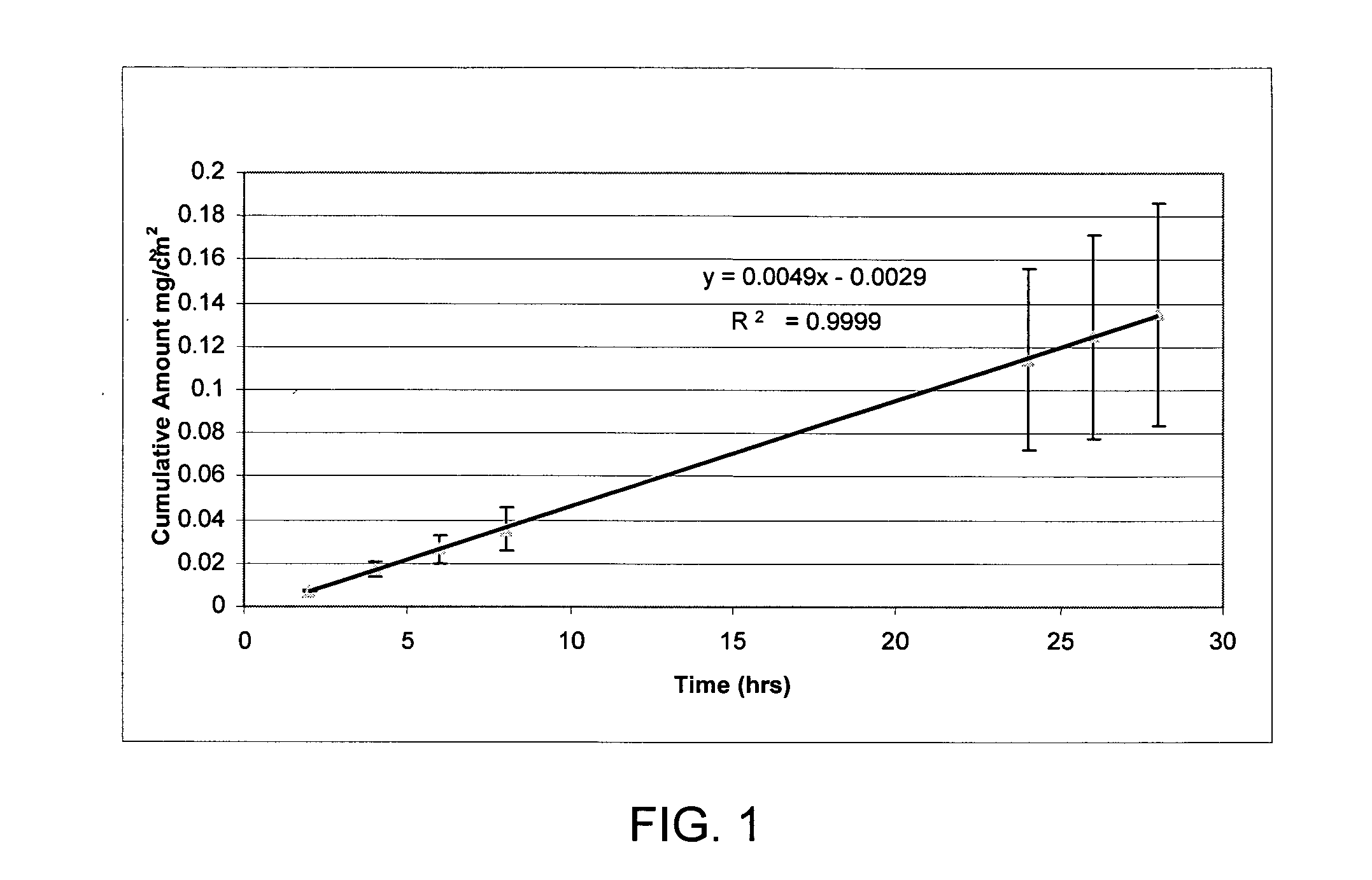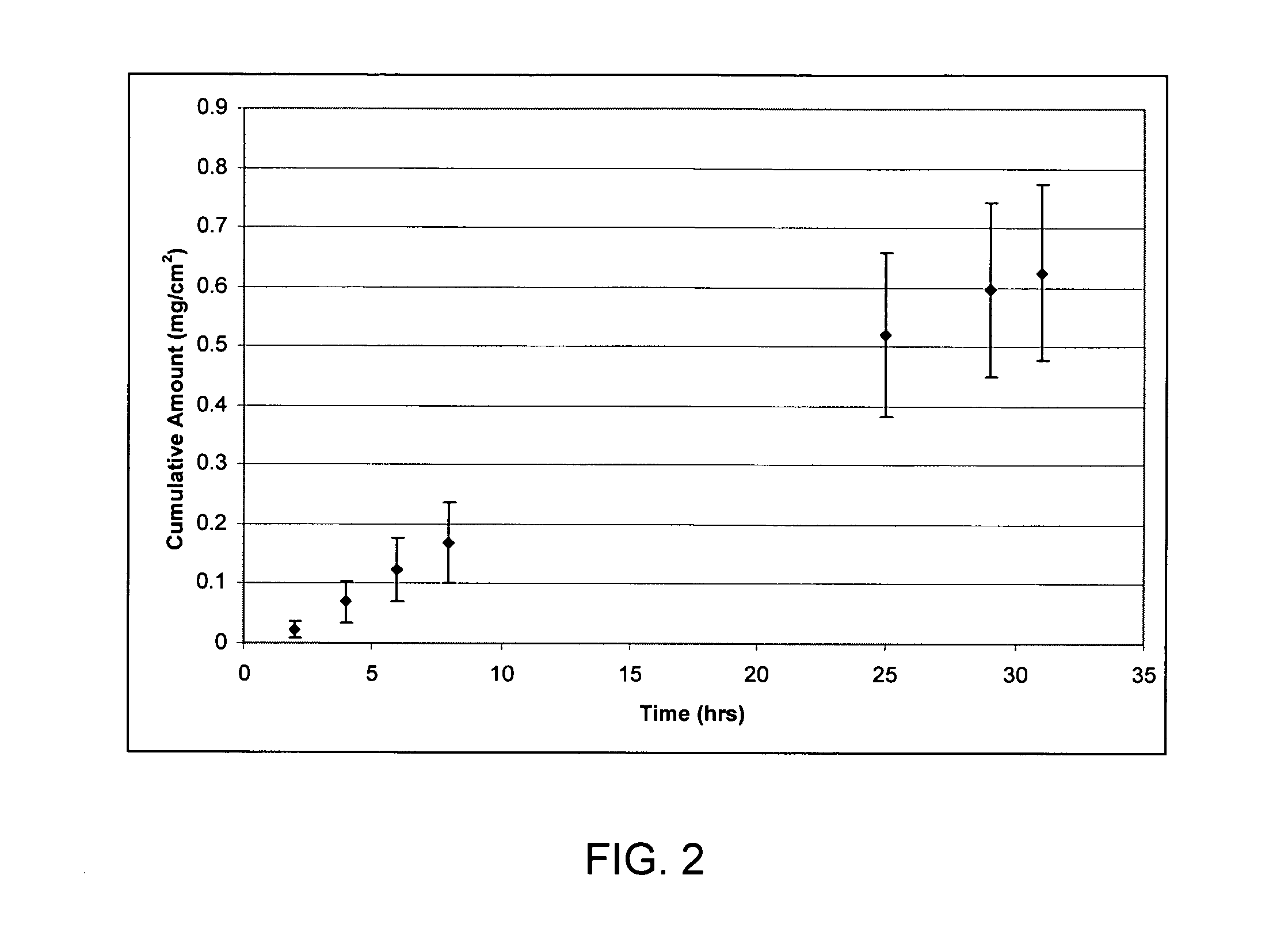Compositions and methods for dermally treating musculoskeletal pain
a technology of musculoskeletal pain and formulation, applied in the direction of biocide, peptide/protein ingredients, aerosol delivery, etc., can solve the problems of significant decrease or even termination of topical drug absorption, insufficient quantity of active drugs in formulations applied to the skin, and insufficient dosage forms of topical drugs. to achieve sustained delivery
- Summary
- Abstract
- Description
- Claims
- Application Information
AI Technical Summary
Benefits of technology
Problems solved by technology
Method used
Image
Examples
example 1
[0084] Hairless mouse skin (HMS) or human epidermal membrane (HEM) is used as the model membranes as noted for the in vitro flux studies described in herein. Hairless mouse skin (HMS) is used as the model membrane for the in vitro flux studies described in herein. Freshly separated epidermis removed from the abdomen of a hairless mouse is mounted carefully between the donor and receiver chambers of a Franz diffusion cell. The receiver chamber is filled with pH 7.4 phosphate buffered saline (PBS). The experiment is initiated by placing test formulations on the stratum corneum (SC) of the skin sample. Franz cells are placed in a heating block maintained at 37° C. and the HMS temperature is maintained at 35° C. At predetermined time intervals, 800 μL aliquots are withdrawn and replaced with fresh PBS solution. Skin flux (μg / cm2 / h) is determined from the steady-state slope of a plot of the cumulative amount of permeation versus time. It is to be noted that human cadaver skin can be used...
example 2
[0085] Formulations of ropivacaine (base) in various non-volatile solvent systems are evaluated. Excess ropivacaine is present. The permeation of ropivacaine from the test formulations through HMS is presented in Table 2 below.
TABLE 2Skin Flux*Non-volatile solvent system(mcg / cm2 / h)Glycerol1.2 ± 0.7Tween 202.4 ± 0.1Mineral Oil8.9 ± 0.6ISA (Isostearic Acid)11 ± 2 Span 2026 ± 8
*Skin flux measurements represent the mean and standard deviation of three determinations. Flux measurements reported were determined from the linear region of the cumulative amount versus time plots. The linear region was observed to be between 4-8 hours. If experimental conditions allowed, the steady-state delivery would likely continue well beyond 8 hours.
Steady state flux of ropivacaine base from the above non-volatile solvents are obtained by placing 200 mcL on the stratum corneum side (donor) of hairless mouse skin. The in vitro studies are carried out as described in Example 1. From Table 2, the non-v...
example 3
[0086] Formulations of diclofenac sodium in various non-volatile solvent systems are evaluated. Excess diclofenac sodium is present. The permeation of diclodenac sodium from the test formulations through HMS is presented in Table 3 below.
TABLE 3Skin Flux*Non-volatile solvent system(mcg / cm2 / h)Glycerol1.7 ± 0.3Isopropyl Myristate13 ± 3 Ethyl Oleate14 ± 4 Propylene Glycol30 ± 30Span 2098 ± 20
*Skin flux measurements represent the mean and standard deviation of three determinations. Flux measurements reported were determined from the linear region of the cumulative amount versus time plots. The linear region was observed to be between 4-8 hours. If experimental conditions allowed, the steady-state delivery would likely continue well beyond 8 hours.
Steady state flux of diclofenac sodium from the above non-volatile solvents are obtained by placing 200 mcL on the stratum corneum side (donor) of hairless mouse skin. The in vitro studies are carried out as described in Example 1. From Tab...
PUM
| Property | Measurement | Unit |
|---|---|---|
| boiling point | aaaaa | aaaaa |
| initial viscosity | aaaaa | aaaaa |
| initial viscosity | aaaaa | aaaaa |
Abstract
Description
Claims
Application Information
 Login to View More
Login to View More - R&D
- Intellectual Property
- Life Sciences
- Materials
- Tech Scout
- Unparalleled Data Quality
- Higher Quality Content
- 60% Fewer Hallucinations
Browse by: Latest US Patents, China's latest patents, Technical Efficacy Thesaurus, Application Domain, Technology Topic, Popular Technical Reports.
© 2025 PatSnap. All rights reserved.Legal|Privacy policy|Modern Slavery Act Transparency Statement|Sitemap|About US| Contact US: help@patsnap.com


